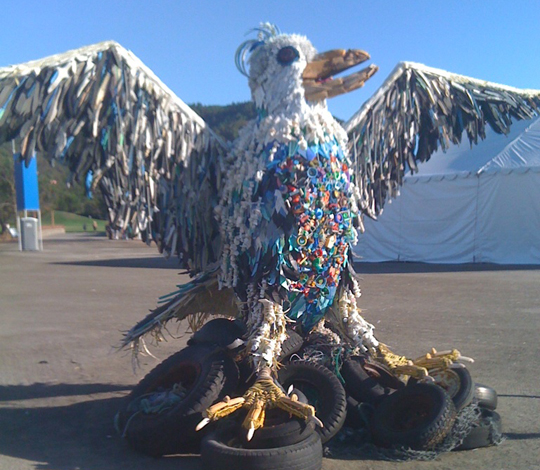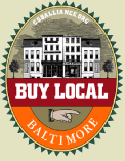11 thrivability lessons from Bioneers 2010

Two dear friends, Erin Mitchell of BlueGreen Acupuncture and Tracy Ward, publisher of Urbanite magazine, are live in Marin, CA, at the Bioneers conference. Here is the first of their dispatches.
I am busting at the seams with inspiration here in Marin County, San Rafael California at the 22nd annual national Bioneers Conference. The Agricultural institute of Marin took us on a 9-hour tour of what’s really going on with agriculture, food and farming. I was with a group of about 45 folks today on this tour of Marin County’s farms and the latest in “thrive-ability” projects. Just so you know…the new buzz word is “thrive-ability” to replace its less enthusiastic sister, “sustainability”. One comes from abundance and the other comes from mediocrity. And I assure you the former is what’s happening!!! Thrive-ability!
It’s been less than 24 hours and I’ve already learned so much:
- We will be able to sequester carbon emissions 4 times the amount of our output simply by using organic compost to fertilize grass-grazed pastures.
- We can harvest seeds in weeds that are native to the land for our food supply of necessary complex carbohydrates (and they taste AWESOME).
- Extra virgin olive oil purchased in the U.S. only has to be 10% virgin for it to count as being extra virgin. And that the only thing that can kill an olive tree is too much water (not even fire can kill it)
- Diversifying farms are key to viability. For example, a 140-year-old organic dairy farm (which was only 75% organic for a VERY good reason) has started a pumpkin patch and cheese factory in order to bring in more income to the land.
- From my lessons from Suzie Q I taught the group how to stick four fingers in a baby calf’s mouth and they will suck until the sun goes down – it’s gotta be one of the coolest feelings!
- You can ferment rice to make lactose and spray lettuce leaves to kill microbes and create greens that are full of nutrients instead of eating lettuce that’s only nitrogen and water (even the “organic” stuff may not be nutrient filled. )
- Growing rabbit is a very economical and sustainable way of producing protein and it doesn’t need refrigeration. Imagine.
- We are teaching the Rabbit growing techniques to emerging countries like Haiti. This was started by a mom helping her daughter with a 4H project in school and has now turned into an international model!
- You can be a beginner in change.
- You can stumble into your passion and world work if you stay open.
- What’s most astonishing is that the people who have discovered these things range anywhere from construction workers to software developers to graphic designers to children’s book writers. The common theme with all of them is they decided at a point in their lives not to focus on their failures but rather to focus on what was going right and making their successes thrive.
Quotes from ordinary people today….
“I want all the children to know that underneath the concrete is a beautiful garden.”
“We can measure democracy by what’s on the plate at school lunch.”
“Nature misses us.” (Referring to a native plant/weed that produces a delicious seed and it’s dying off. It only reproduces or grows if you pick it. HA!)
P.S. from Tracy:
Yesterday was equally inspiring with learnings from the CEO of Stonyfield Farms, a guy who started making organic yogurt in his backyard and now has a 310 million dollar company that is profitable and supports local farms. The company has figured out that making decisions that are good for the planet have boosted profitability every step of the way.
And later, we heard from a team of people who have figured out how to manage grazing in such a way to fully restore habitats lost to desertification (due to over grazing), all while increasing profitability, carbon sequestration, and amazingly the land’s capacity to handle more grazing. And, finally, a presentation by a totally inspiring woman from Brooklyn who has started an urban farm that makes me weep with possibility.
* * * * *
Stay tuned for more updates. We’d love to hear your comments — what inspires you about this news?





 View the dynamic, moving GOforChange: Greening Baltimore video
View the dynamic, moving GOforChange: Greening Baltimore video

Comment by Jean Russell on 18 October 2010:
I am so excited to see this. Fantastic.
The link for thrivability to the piece on Appropedia is a snippet taken from http://www.thrivable.org. We released a collaborative ebook on Thrivability in March, so it is great to see that the meme is spreading. So exciting!
And here is an interview on Worldchanging from last September: http://www.worldchanging.com/archives/010455.html
Comment by Lonny on 18 October 2010:
Hi Julie,
Thanks for the great post, I really like the parts on food. So many great steps are being made to unleash the gardens from under concrete and onto school plates!
Thanks also for linking to Thrivability on Appropedia. We were inspired to embed a great community sketch on Thrivability (full disclosure: I am a minor contributor) there – http://www.appropedia.org/Thrivability.
-Lonny